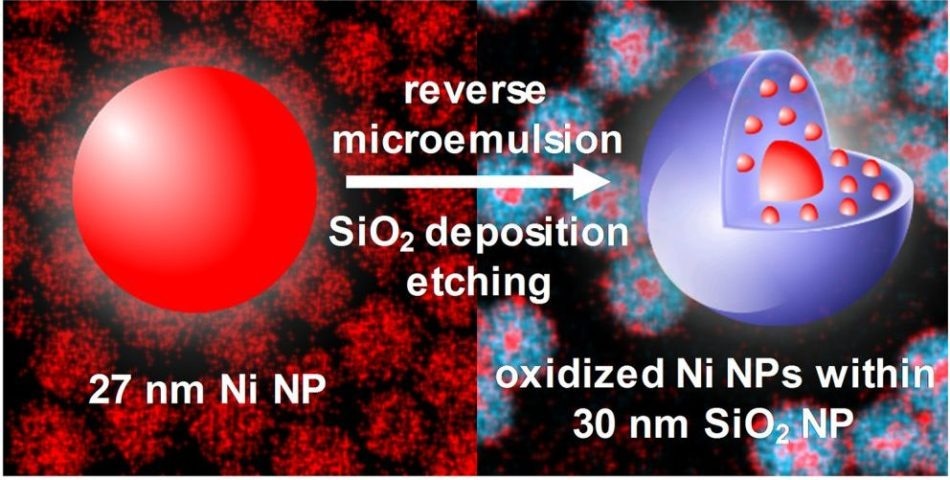Nov 29 2017
A team of researchers from North Carolina State University and the Air Force Research Laboratory have found out that a method meant to coat nickel nanoparticles with silica shells in reality fragments the material – forming a small core of oxidized nickel surrounded by smaller satellites embedded in a silica shell. The unexpected result may prove beneficial by expanding the surface area of nickel available for catalyzing chemical reactions.
 During deposition of a silica shell onto Ni nanoparticles, they are etched, oxidized, and embedded in the silica, which stabilizes the structure during oxidation and reduction. Credit: Brian Lynch. Reproduced by permission of The Royal Society of Chemistry.
During deposition of a silica shell onto Ni nanoparticles, they are etched, oxidized, and embedded in the silica, which stabilizes the structure during oxidation and reduction. Credit: Brian Lynch. Reproduced by permission of The Royal Society of Chemistry.
Nickel is noteworthy for its widespread applications in catalysis, one reason you’d want to coat nickel nanoparticles in porous silica is to embed them in a neutral substrate to maintain their efficiency as catalysts in chemical reactions. So the fact that this process could increase their surface area at the same time could prove to be beneficial.
Joe Tracy, associate professor of materials science and engineering at NC State and corresponding author of a paper on the research. “
The team used an approach known as reverse microemulsion, or reverse micelle, to apply a silica coating to nickel nanoparticles that were about 27 nm in diameter. But they discovered that the method results in an oxidized nickel core that was 7 nm in diameter, surrounded by oxidized nickel satellites just 2 nm in diameter – all surrounded in a silica shell that was 30 nm in diameter.
“At first we thought we’d made a mistake, but we were able to reproduce the result over and over again,” says Brian Lynch, a Ph.D. student at NC State and lead author of a paper on the research.
“When oxidized and reduced at high temperatures, we found that the core-and-satellite nickel nanoparticles did not significantly change size or shape, suggesting that they would function well in the environments needed to catalyze chemical reactions,” Tracy says.
“This was an unexpected discovery, but we’re happy with how it turned out.”
The paper titled, “Synthesis and Chemical Transformation of Ni Nanoparticles Embedded in Silica,” has been published in the Nanoscale journal. The paper was co-authored by Bryan Anderson, a former Ph.D. student at NC State, and Joshua Kennedy of the Air Force Research Laboratory. The research was supported by the National Science Foundation, the Air Force Research Laboratory Materials and Manufacturing Directorate, and the Air Force Office of Scientific Research.